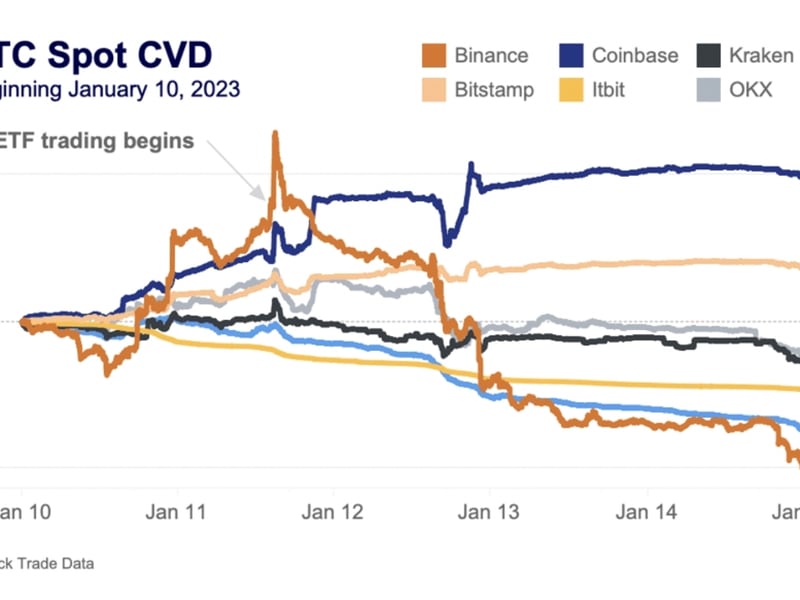Bitcoin's 'Sell The Fact' Pullback Came From Binance, OKX: Kaiko

Bitcoin [BTC] has come under pressure since spot exchange-traded funds (ETF) began trading in the U.S. last Thursday. Data tracked by Paris-based Kaiko show the selling pressure has been concentrated on Binance, the leading crypto exchange by trading volumes, OKX, and Upbit.
Bitcoin, the leading cryptocurrency by market value, changed hands at $42,700 at press time, representing a 12% drop from the high of $48,975 reached Thursday. The price drop seems to have stemmed from traders taking profits on long (buy) positions initiated in anticipation of ETFs’ debut.
An indicator called the cumulative volume delta (CVD) shows traders from Binance led the so-called “sell-the-fact” pullback in bitcoin. The CVD tracks the net difference between buying and selling volumes over time, offering a total of net bullish/bearish pressures in the market. Positive values indicate excess purchase volume, while negative values suggest otherwise.
Binance’s spot market CVD flipped positive last Thursday and has been falling ever since, representing a capital outflow equivalent to nearly 5,000 BTC, data tracked by Kaiko show. South Korea’s Upbit has seen the second-largest net capital outflow, followed by Itbit and OKX.
“The ETFs began trading last Thursday, with a strong surge in cumulative volume delta (CVD) across all major exchanges; a net of nearly 3k BTC was market bought on Binance in the hour surrounding market open in the U.S. However, as some had feared, sell the news took hold, and Binance’s CVD quickly fell into the negative, as did OKX’s,” Kaiko said in a weekly report published Monday.
“Itbit, another institutional exchange, though with lower volumes, showed consistent selling, along with Upbit, showing consistent selling with few retraces,” Kaiko added.

The CVD on Coinbase, the custody partner for most of the ETFs, and Bitstamp has held positive, implying a net capital inflow amid the price weakness.
Per some analysts, prices could slide further to $40,000 and lower before the pullback runs out of steam. The initial performance of the ETFs has been weak relative to Bloomberg analysts’ projection of $4 billion in inflows on the first day alone, which supports the case for a deeper price drop.
On the second day of trading, #BTC ETFs (Jan 12th) saw inflows of USD677mn (ex-Grayscale). The cumulative first two trading days of the BTC ETFs have a balance of $1.4bn ex-Grayscale and $0.8bn including grayscale.
— Exante Data (@ExanteData) January 15, 2024
More than half of the flows went to the iShares Bitcoin ETF… pic.twitter.com/vtVXdXfvvN








